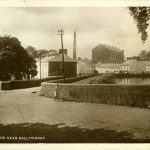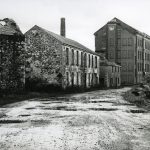Balnamore Mail Bag – Audio Description

Lower Bann Voices Oral History Interview with Nigel Flynn (Audio) – Local History, Pubs and Storytelling – Recorded March 2022
5th April 2022
Leslie Bell Oral History Interview Lower Bann Voices – Farming Families in Duneane, Rural Crafts and Crop Production – Audio and Analysis
11th May 2022Balnamore Mail Bag – Audio Description
Project Attributes
Project:
Owner:
Date:
6th April 2022
On permanent display in Ballymoney Museum is a mail bag from Balnamore Mill used by William Rafferty Orr, a postal worker who identified as blind and had a long career delivering mail between the mill and Ballymoney. The mail bag was the focus of a community engagement programme with visually impaired participants as part of ‘Addressing Health’, a research project exploring the health of postal workers in the Victorian and Edwardian Post Office.
The Addressing Health project is funded by a Wellcome Collaborative Award in Humanities and Social Science and is a collaboration between King’s College London, Kingston University, University of Derby and University College London, in partnership with The Postal Museum. This community engagement project was funded by the Wellcome Public Engagement Enrichment Fund, one of several that has partnered with regional museums across the UK.
The following recording combines the project research with the observations of the programme participants to provide an audio description of the Balnamore Mail Bag.
On display is a mail bag, from the Balnamore linen mill, an important business in the region until it closed in 1959.
Records show that this bag was carried by one William Rafferty Orr, who delivered post for the mill. William is notable because the 1911 census shows that he was registered blind, and contemporary accounts describe how he walked his route with confidence, and needed no cane or help to find his way.
The bag is a rich brown leather satchel, worn and weathered from age and many years of use, but we can deduce some interesting things from close examination of its appearance.
It has a bronze, lozenge shaped name plate on the front, with the words Balnamore Spinning Co engraved in block capital letters, proudly marking this satchel as the property of the mill, and indicating that William Orr was their private employee, couriering their correspondence.
The first thing to note is the leather. To the touch it is stiff and hard. And although the bag isn’t very large, a little bigger in length and height than an A4 jotter, it is heavy to lift. It is a deep, dark colour, almost black in places. A leatherworker who examined the bag said it had certainly been lighter in colour when it was new, more of a light tan, but frequent use in rain and sun has deepened the colour and stiffened the texture. It has cracks and rips and shows wear and tear.
The flap of the satchel, the back and the front are all cut from one big piece of hide. The sides are made from smaller pieces, and it’s all painstakingly hand stitched together. On the right-hand side of the bag the stitching is close and done with a fine waxed thread. Pushing a needle through the layers of tough leather and keeping the stitches so small and neat and tight together would have been very skilled work and shows the pride the mill took in the quality of everything associated with them.
On the left-hand side the stitching is different, a rougher blanket stitch. It suggests the bag was torn at the seam at some time and repaired by a less skilled hand. But the bag still had value and rather than being replaced it was mended and made good again.
There are three steel eyelets along the top edge of the satchel, just about big enough to poke a little finger through. And three matching buttonholes in the flap of the satchel. The buttonholes are torn through now, but when it was in use and the bag was closed, it would have protected the contents from the wind or rain.
There’s a short brassy link chain hanging from the first eyelet. It looks like another ‘make do and mend’ addition to the bag but may give us another clue about how it was used. The leather between the eyelets is scored and darkened, like a groove has been worn by the action of a bar being threaded through the eyelets. We can only speculate about the purpose, but it seems likely this was a security measure. If the chain bore a padlock, the bar could be locked in place and the bag couldn’t be opened by anyone who didn’t have a key.
There is a leather strap attached to the bag, about an inch thick, with a brass buckle to adjust the length. The strap feeds through a leather patch, neatly sewn across the back of the bag, to hold the strap in place. William Orr would have slung the satchel across his shoulder to carry the mail to and from the mill. The strap has been crudely shortened by being tightly coiled through the buckle three times and fixed in place with a new hole. We can imagine that William or the last person to use the mail bag wanted the satchel to sit more comfortably on their hip. The leather of the bag even seems polished like it had long rubbed against the trousers of the carrier on a regular journey. It was probably worn on their left-hand side, maybe so they could dip into the bag with their right hand.
Inside the satchel is untreated leather, almost like suede in its light colour compared to the rest of the bag. There are strands and marks like there was once a lining, but it is long gone. There’s no evidence that there were any pockets or compartments.
There wouldn’t have been room for bulky packages or parcels, so the final thing we can speculate about is the nature of the post travelling between the mill and the Ballymoney post office. It may have included correspondence between the booming linen businesses of the day, invoices and bills for payment demanded, orders for fine houses, dress makers, maybe the companies fitting out ocean liners and even cash payments for suppliers and workers might all have been carried by William Orr. The security mechanism built into the satchel would have protected the valuable contents of the mail bag, and made William feel a little more safe from potential mishaps on the road between Ballymoney and Balnamore Mill.
- Balnamore Mill and village, 1939
- Balnamore Mill
- Balnamore Mill reeling room, 1953
- Balnamore Mill
- Balnamore Mill mail bag & tools






